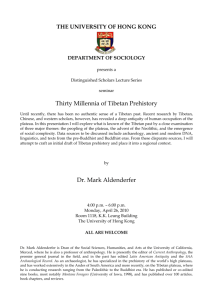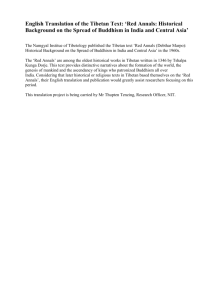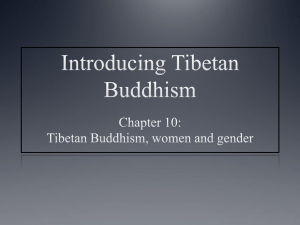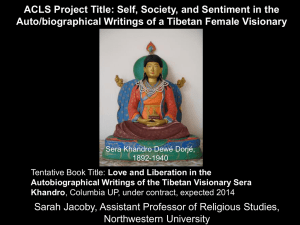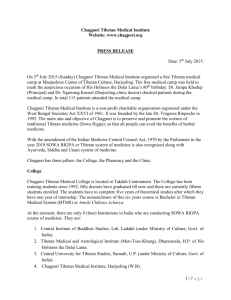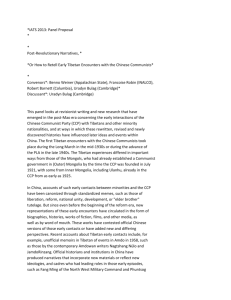Consonants
advertisement
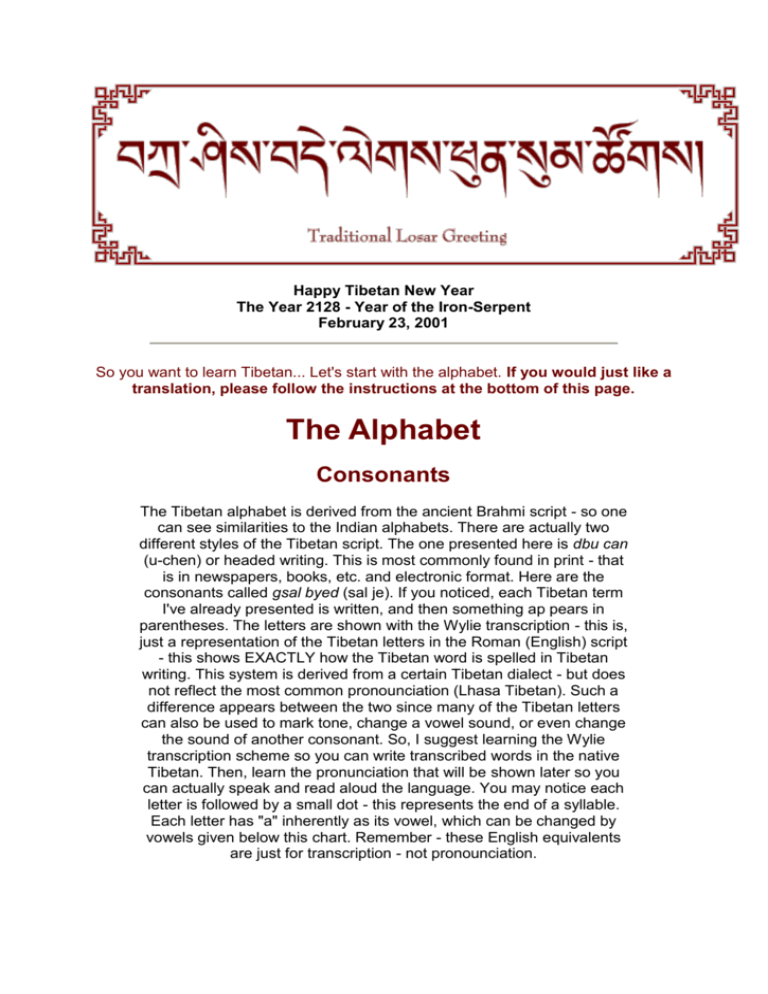
Happy Tibetan New Year The Year 2128 - Year of the Iron-Serpent February 23, 2001 So you want to learn Tibetan... Let's start with the alphabet. If you would just like a translation, please follow the instructions at the bottom of this page. The Alphabet Consonants The Tibetan alphabet is derived from the ancient Brahmi script - so one can see similarities to the Indian alphabets. There are actually two different styles of the Tibetan script. The one presented here is dbu can (u-chen) or headed writing. This is most commonly found in print - that is in newspapers, books, etc. and electronic format. Here are the consonants called gsal byed (sal je). If you noticed, each Tibetan term I've already presented is written, and then something ap pears in parentheses. The letters are shown with the Wylie transcription - this is, just a representation of the Tibetan letters in the Roman (English) script - this shows EXACTLY how the Tibetan word is spelled in Tibetan writing. This system is derived from a certain Tibetan dialect - but does not reflect the most common pronounciation (Lhasa Tibetan). Such a difference appears between the two since many of the Tibetan letters can also be used to mark tone, change a vowel sound, or even change the sound of another consonant. So, I suggest learning the Wylie transcription scheme so you can write transcribed words in the native Tibetan. Then, learn the pronunciation that will be shown later so you can actually speak and read aloud the language. You may notice each letter is followed by a small dot - this represents the end of a syllable. Each letter has "a" inherently as its vowel, which can be changed by vowels given below this chart. Remember - these English equivalents are just for transcription - not pronounciation. Click here if you would like to see the dbu med (u-me) or "headless writing" alphabet. Vowels Here are the vowels or dbyangs (yang). Each letter above has an inherent "a" pronounced like "but." In order to change this vowel to another sound (ie. if the vowel is not "a"), a mark is placed above or below the consonant. A vowel written alone uses either the Tibetan letter a or 'a - the difference in transcription symbol is only to represent a different letter form. I is pronounced like "fit." E is pronounced like "May." U is pronounced like "foo d." The names of the vowels are - gi-gu, shup-ju, dreng-bu, and na-ro Consonants Conjuncts One will frequently find consonant stacks - that is letters on top of each other. Some letters take special forms when being stacked. Here are those special forms attached to the letter k for the sake of example. Some characters always form these stacks even if they do not have a special form. Three are called rango, lango, and sango. These mean that the letters ra, la, and sa are superscribed (or on top of) another letter. The subscribed forms are wata, yata, rata, lata, and hata. Here are examples are all of these attached to "g" - combinations of more than one of these are also given. Remember, whenever you see these letter combinations with any other letter, a stack will appear: 1 - ga; 2 - gwa; 3 - gya; 4 - gra; 5 - gha; 6 - gla; 7 - rga; 8 - lga; 9 - sga; 10 - grwa; 11 - rgwa; 12 - rgya; 13 - sgya; 14 - sgra These seem to be strange combinations of sounds... but remember, this does not necessarily relfect the pronounciation - for example, the stack gra is pronounced "Tha". If you see any examples such as these in transcribed Tibetan, the letters are written in a stack instead of next to eachother. Sanskritic Letters The Tibetan alphabet was created also with the idea for using it to write Sanskrit words. So, extended letters were created to account for the letters not found in the Tibetan alphabet. These are pretty easy to figure out - they are not really a part of the alphabet - you should be at least familiar with them although they appear infrequently. "T, TH, D, N, and SH" are retroflex consonants. "H" is a visarga and pronounced like a breathy "h". "M" is an anusvAra and represents nasalization. The others represent Sanskrit long vowels. Numbers Let's not forget the numbers. For the most part, they operate like our number system. I suggest printing out the main consonants and vowels for a handy reference. Here are some pronunciation tips: An "h" after a letter like th represents extra air blown out or aspiration - do not pronounce like "they." Same goes with ph do not pronounce like "phone." Consonants not followed by "h" have little or no aspiration - this can be difficult to distinguish for English speakers. Try putting your hand in front of your mouth. Pronounce the words "kill" and "skill". The "k" in "kill" is aspirated where as in "skill" it is not. The letter ng is pronounced like in "sing" but not really with a "g" sound at the end. This is important to learn to pronounce especially since the word for "I" is nga. The letters are in groups going across - first are the velars - said from the back of the mouth. The second group is the palatals - said with the tongue touching the roof of the mouth. The third is the dentals - the tongue touches the back of the teeth. The fourth is the labials - the lips come together. Putting it all Together Syllables Now that you know the basic workings of the alphabet, you can start looking at how words are put together. Take a look at this mantra - the most well known mantra in Tibetan Buddhism. Then after looking at it, transcribe it using the Wylie scheme. If you got - "oM ma Ni padme hUM" - then you are probably a genius. This is a very hard phrase to read because it is really Sanskrit. Notice, a nasalization circle over the o vowel sign. Notice a retroflex N. Notice the consonant stack of dm. Notice the Sanskrit long vowel U. And finally notice the nasalization sign over the h. You probably also noticed little dots - this little dot is called a tsheg (tsek). This little dot separates syllables. T his may seem unnecessary at this point, but when you start looking at Tibetan words, it will become invaluable. Also, you may have noticed the vertical line at the end of the phrase. This is called a (shey) and it is the closest form of punctuation to a period. Actually, it is probably the only punctuation besides a tsek you will ever see. When Tibetan is transcribed, a tsek most frequently simply becomes a space. Sometimes a dash is used so one can tell how the words are separated. Phrases These are some common, every day type phrases, to learn. As you will see, reading Tibetan can be more difficult than you probably thought. An approximate pronunciation is given below the translation. Notes: 1 - "Where are you going?" is a common greeting. 2 - Kah-leh phe is said to the person leaving, or if both people are leaving. 3 - Kah-leh shu is said to the person remaining behind. 4 - These phrases are not commonly spoken and should not be used as freely as they are in English. Practice For some transcription practice, transcribe the phrases above (using the standard Wylie method). Remember to transcribe a tseg simply as a space. Please check the Conjuncts section to review the rules for forming stacks. Most syllables will only contain one vowel so some letters will not have an attached vowel. For an example, here is the answer to number one: 1 - bkra shis bde legs/ Now write down the transcription for all the other phrases. Check your work - here are the answers: 2 - khyed rang sku gzugs bde po yin pas/ 3 - lags yin/ nga gzugs po bde po yin/ 4 - bzhugs rogs gnang/ 5 - khyed rang ga par phebs kas/ 6 - ga ler phebs/ 7 - ga ler bzhugs/ 8 - mjal yong/ 9 - do dgong mjal yong/ 10 - sang nyin mjal yong/ 11 - gzim 'jag gnang dgos/ 12 - kong dags/ 13 - thu ci che/ 14 - bod rang btsan/ Pronounciation Here comes the hard part! I have put off pronounciation so far, but as can probably tell, there is a huge difference between the Wylie transcription and the actual pronounciation. It is very useful to know the Wylie transcription to be able to write out Tibetan words correctly in the native script. I have for some time been working on a pronounciation guide, but I only have a very rough version. The information is highly technical, but I think it can be of some use. Click here to see this work in progress. Bookstore Recommended Books for begining study and for fun: Lonely Planet Tibetan Phrasebook Learning Practical Tibetan Where Is Tibet : A Story in Tibetan and English Buddhist Symbols in Tibetan Culture Lonely Planet Tibet (Travel Guide) The New Tibetan-English Dictionary of Modern Tibetan Search Now: Translations If you are interested in translating a word or phrase into Tibetan or from Tibetan, visit this Online English-Tibetan Dictionary. I am unable to provide any translation services - please do not contact me for translations into or from any languages. Email - I cannot provide any translations and will not reply to translation requests.
